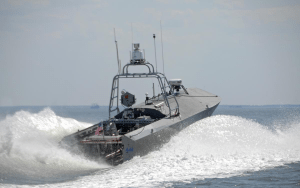
NATIONAL HARBOR, Md.--The U.S. Navy plans to take a “hard look” at what its future unmanned surface vessels (USVs) should look like, including whether it should develop “purpose-built” vessels or equip existing manned systems to operate in unmanned or optionally manned mode, a program official said April 3.A series of studies “over the next couple of years” is expected to help the Navy answer such questions, said Howard Berkof; deputy program manager for unmanned systems in the Program Executive Office…

 By
By 











